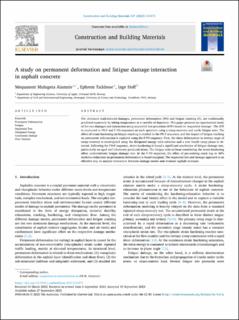A study on permanent deformation and fatigue damage interaction in asphalt concrete
Peer reviewed, Journal article
Published version
Permanent lenke
https://hdl.handle.net/11250/3126891Utgivelsesdato
2023Metadata
Vis full innførselSamlinger
Originalversjon
Alamnie, M. M., Taddesse, E. & Hoff, I. (2023). A study on permanent deformation and fatigue damage interaction in asphalt concrete. Construction and Building Materials, 407, Article 133473. https://doi.org/10.1016/j.conbuildmat.2023.133473Sammendrag
The dominant load-induced damages, permanent deformation (PD) and fatigue cracking (F), are traditionally predicted separately by taking temperature as a variable of departure. This paper presents an experimental study of the two damages and interaction using sequential test procedure (STP) based on ‘sequential damage’. The STP is conducted in PD-F and F-PD sequences on each specimen using a creep-recovery and cyclic fatigue tests. The effect of strain hardening on fatigue cracking is studied in the PD-F sequence, and the impact of fatigue cracking on permanent deformation is explored using the F-PD sequence. First, the shear deformation in tertiary stage of creep recovery is investigated using the dissipated energy ratio criterion and a new fourth creep phase is obtained. Following the PD-F sequence, strain-hardening is found a significant accelerator of fatigue damage rate, particularly on aged and laboratory produced mixes. The fatigue tests without considering the strain-hardening effect underestimate fatigue damage rate. In the F-PD sequence, the effect of pre-existing crack (up to 40% modulus reduction) on permanent deformation is found marginal. The sequential test and damage approach is an effective way to analyze interaction between damage modes and evaluate asphalt mixtures.

